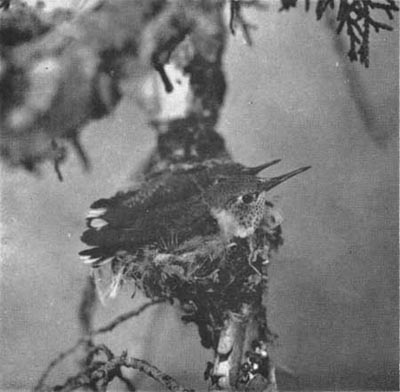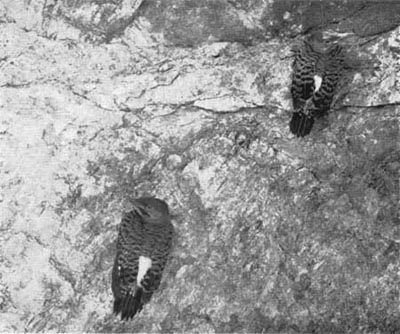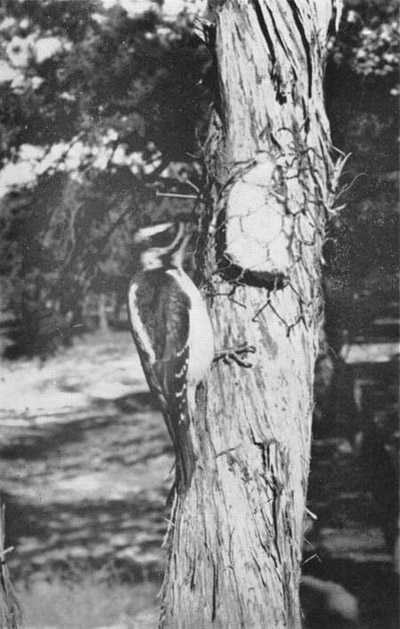|
ZION, BRYCE CANYON, CEDAR BREAKS
Birds of Zion, Bryce and Cedar Breaks |

|
Zion-Bryce Museum Bulletin
Number 5
THE BIRDS OF ZION, BRYCE, AND CEDAR BREAKS
DESCRIPTION OF SPECIES
(continued)
| BLACK-CHINNED HUMMINGBIRD (Archilochus alexandri). | |
| Field Marks: |
One of the smallest birds of the region. Male, upper parts green with a bronze tinge; chin black, with a brilliant purplish-blue band below; a white collar across the breast; under parts light. Female, upper parts greenish, under parts whitish. |
| Occurrence: |
ZION. Common summer resident from March to September. Found from the canyon bottoms to the rim. Nests in May, June and July. BRYCE CANYON. Common summer resident along the rim and in the canyons around 8,000 feet and below. Nests in June. |
|
This is the commonest hummingbird in the Zion region, being especially abundant around the slopes when the cacti are in bloom. During breeding season the male carries on his courting activities by buzzing back and forth over the female in a series of short dashes, pendulum fashion, often with such speed that he can scarcely be seen. The nest is placed about ten feet from the ground, and is a work of art, so delicately is it constructed. After the nest is built and the eggs laid, the male apparently leaves the incubation of the eggs and the raising of the young to his mate. | |
| COSTA'S HUMMINGBIRD (Calypte costae). | |
| Field Marks: |
An exceedingly small bird. Male, upper parts greenish-bronze; wings brownish; under parts dusky, washed with yellow or green; top of head, throat and feathers of the "gorget" purple or amethyst. Female, upper parts greenish, under parts whitish. |
| Occurrence: |
ZION. Common summer resident in the lower portions of the park, being especially abundant around Coal Pits Wash. |
|
This is a bird of the arid zone, being especially fond of dry washes where cactus and yucca are found in abundance. Its nest is usually situated only a few feet from the ground, and, compared to the Black-chinned nest, is very poorly constructed. The male Costa carries on his courting activities in a somewhat different fashion from the Black-chinned. He seeks to impress the female by aerial acrobatics that are a marvel to watch. This usually consists of a number of gyrations, climaxed by a lightning-like "power dive" past the perched female, with a loud, explosive chatter at the bottom of each dive. | |
|
| |
| BROAD-TAILED HUMMINGBIRD (Sclasphorus platycercus platycercus). | |
| Field Marks: |
About the size of the preceding species. Male plumage greenish, lighter on the stomach; throat bright rose-red. Female, very similar to the female Costa and Black-chinned, but with buffy sides. |
| Occurrence: |
ZION. Common summer resident above 5,000 feet. BRYCE CANYON. Common summer resident throughout the park. CEDAR BREAKS. Common summer resident, being especially abundant in the flower gardens along the rim and around Brian Head. |
|
This species of hummingbird can readily be told from others in the region by the shrill, metallic trill created by its wing while in flight. The courting antics of the male is somewhat similar to that of the Costa. Rising high above the ever observant female, the male dives with terrific speed past his prospective mate, rises and hovers an instant in mid-air, and then repeats the entire proceedings. Usually more than one brood of young are raised each summer, with the adults following the flower season into the higher elevations. | |
|
| |
| RED-SHAFTED FLICKER (Colaptes cafer collaris). | |
| Field Marks: |
Large robin size. Adults, general coloration brownish; feather shafts on wings and tail red on undersides; tail black; rump white; under parts whitish with round black spots; black crescent across breast. Male and female very similar, but the male has a red stripe down the side of the head, while in the female this stripe is brownish. |
| Occurrence: |
ZION. Common permanent resident at all elevations. Nests in June. BRYCE CANYON. Common permanent resident at all elevations. CEDAR BREAKS. Common summer resident; may be permanent resident, but records are lacking. |
|
The bounding flight of this bird immediately marks it as being a member of the woodpecker family, while the white rump and reddish flash when the wings are opened are excellent field marks. Unlike most of the woodpeckers, the flicker spends much time on the ground Ants are a favorite food, and great quantities are consumed around the large ant hills. Cavities are drilled into old snags, posts or suitable trees for nesting sites. These holes are usually only a few feet from the ground. | |
| LEWIS'S WOODPECKER (Asyndemus lewis). | |
| Field Marks: |
Robin size. Adults, upper parts black; lower parts gray, changing to rose-red on the belly; a gray collar across the back of the neck; forehead and sides of head dark red. |
| Occurrence: |
ZION. Uncommon summer resident, occasionally staying until early December. Found in the ponderosa pine belt above 6,000 feet. BRYCE CANYON. Rare summer visitant. Probably a summer resident, but records are lacking. |
|
The flight of this bird is more like that of a crow than of a woodpecker. Instead of rising and falling in the typical bounding flight of the woodpecker, it has a steady, continuous wingbeat. Unlike most members of this family, the Lewis' Woodpecker is rather quiet. It also has a curious habit of catching insects on the wing, which is a most unwoodpeckerlike trait. It is a great traveler, wandering from low country in the winter to high elevations in the summer. | |
| RED-NAPED SAPSUCKER (Sphyrapicus varius nuchalis). | |
| Field Marks: |
A small woodpecker, about bluebird size. Adults, upper parts speckled with black and white; under parts yellowish, sides streaked with black; crown on head red, bordered by black; throat red; breast black; prominent white stripe along the bend of the wing. Female differs from the male in having a dull colored chest patch. |
| Occurrence: |
ZION. Uncommon permanent resident from the lower portions of the park to around 8,000 feet elevation. BRYCE CANYON. Common permanent resident along and below the canyon rim. Nests in June and July. |
|
The Sapsucker is very fond of puncturing the bark of trees to eat the tender, growing layer beneath and to drink the sap that flows from the wound. Insects attracted by the sweet sap are eagerly sought out and swallowed. These holes in the tree are made rather close together, and often form a ring around the trunk. It is this tendency to girdle the tree that makes the sapsucker so unpopular among fruit growers. | |
| NATALIE'S SAPSUCKER (Sphyrapicus thyroideus nataliae). | |
| Field Marks: |
Small robin size. Male, upper parts, including top of head, black; belly yellow; chin red; rump white; wings with large white patch. Female, head and throat brown; upper parts spotted and barred with black and white; band of black across breast; belly yellow. |
| Occurrence: |
ZION. Rare winter visitant. Reported from West Rim on November 15, 1941. Probably a summer resident, but records are lacking. BRYCE CANYON. Fairly common summer resident in the conifers below the rim; uncommon on the rim. |
|
This is the handsomest member of the woodpecker family in the region. The markings of this bird are so prominent as to catch the eye at once. It is definitely a dweller of the coniferous forests, and is seldom found away from the evergreen belt. It is very partial to small aspen groves, where these groves are mixed with spruce or pine. It is a rather shy bird, and seldom stays out where plainly visible. The female is quite different in appearance from the male, a characteristic quite unlike most females of the woodpecker family. For this reason she was for some time thought to be a different species. | |
|
| |
| WHITE-BREASTED WOODPECKER (Dryobates villosus leucothorectis). | |
| Field Marks: |
Large bluebird size. Adults, upper parts black and white; middle of back white; wings black, spotted with white; tail black, outer feathers white; underparts white; nape red. The female is the same coloration as the made, except that the red nape is lacking. |
| Occurrence: |
ZION. Common permanent resident in all of the forested zones. Nests in June and July. BRYCE CANYON. Common permanent resident throughout the park. CEDAR BREAKS. Common permanent resident throughout the wooded regions. |
|
This is the most common woodpecker of the region, and is found wherever trees and high brush are growing. Along the canyon streams, where the broad leaf trees grow in abundance, one can always expect to see these specialists in drilling hard at work, foraging for larvae beneath the bark. This is a variety of the familiar "Hairy," of the country east of the Great Plains. | |
| BATCHELDER'S WOODPECKER (Dryobates pubescens leucurus). | |
| Field Marks: |
Sparrow size. Adults like the preceding species in coloration. |
| Occurrence: |
ZION. Uncommon permanent resident, nesting in the higher forested portions of the park and wintering in the canyons. BRYCE CANYON. Uncommon permanent resident. CEDAR BREAKS. Rare winter visitant. Believed to be a permanent resident, nesting during the summer, but observational records are lacking. All records thus far obtained are during January. |
|
This is one of the western forms of the well-known "Downy," of the eastern part of the United States, but, unlike its eastern cousin, it is seldom seen around the habitations of man. Instead, it lives among the heavy forested sections, from the ponderosa pine belt up into the spruce forest. It shows little nervousness when approached, but goes right on about its business of obtaining food. Like the rest of the woodpeckers, it has an elongated tongue, with a barbed tip, for probing into larvae holes in search of worms. | |


